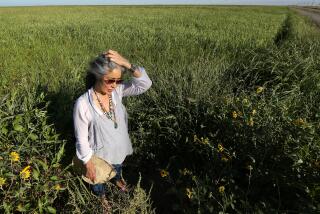‘Dry farming’ starting to take root with state’s winegrowers
- Share via
KENWOOD, CALIF. — Vineyard manager Steve Thomas grasps the trunk of a zinfandel vine, a redwood of the vineyard, gnarled with age and planted in the days when irrigation meant a barrel of water on a horse-drawn cart.
The workhorses and carts are long gone. But these old zin vines at Kunde Estate in Sonoma County still get their water the old-fashioned way, from rain, dew and a deep root system.
They call it “dry farming,” the way agriculture used to be before plastic hoses hooked up to a water supply made deserts bloom. It’s something a few vintners are returning to, driven by factors including concern over dwindling water supplies, the belief that the method produces more intensely flavored fruit, or, as is the case at Kunde, to forge a link with old traditions.
“What you find out is grapevines are incredibly adaptable,” Thomas said.
At the 600-acre Kunde Estate, about 100 acres are dry-farmed and the rest are grown conventionally.
Growing wine grapes without artificial irrigation is practiced in various countries such as Spain and France, where some regions have laws forbidding use of irrigation, said Robert Wample, chairman of the viticulture and enology department at Cal State Fresno.
Dry farming in California is unusual, though there is a trend toward using less water.
“We’re learning to be much more precise early in the growing season so we can control the vegetative growth, minimize the total water consumption and then follow that with good management practices,” he said.
Less water means more intensely flavored grapes and wines; too little water leads to raisins.
Wample, who has studied irrigation techniques for years, sees irrigation as a useful tool in the winegrower’s arsenal although he agrees careful management of how much water is used is crucial as climate- change concerns grow.
“The challenge is understanding how to best utilize water as a management tool,” he said.
For those who do decide to dry farm, the work starts before the vines are planted, said John Williams, founder and winemaker at the Frog’s Leap winery in the Napa Valley and a champion of dry farming.
Farming dry means more than just not irrigating, Williams said. “It’s an active form of preserving moisture in the ground so you don’t need to irrigate.”
Fields are carefully cultivated, mulched and kept under close scrutiny.
“Oh, it’s filthy, dirty work,” Williams said with a rueful laugh. The reward, he believes, “is wines much more deeply connected to the soil, wines much fuller in flavor.”
For Thomas, dry farming is also about connecting to the past.
He uses a trusty truck, not a horse, to navigate the twists and turns of the terraced vineyards of Kunde Estate. But sometimes when he’s out in the fields, seeing how the vines are doing, checking shoot tips to see whether they’re straight, an indication they’re getting enough water, he thinks about past vineyard workers.
“When I visualize a family member out here at the turn of the century behind a horse, plowing this thing, that’s pretty incredible when you think about it,” he said.
“The fact that they’re pruning the same vines and worrying about the same things, frost and whatever else, this is a kind of commitment that’s passionate.”
More to Read
Sign up for Essential California
The most important California stories and recommendations in your inbox every morning.
You may occasionally receive promotional content from the Los Angeles Times.










